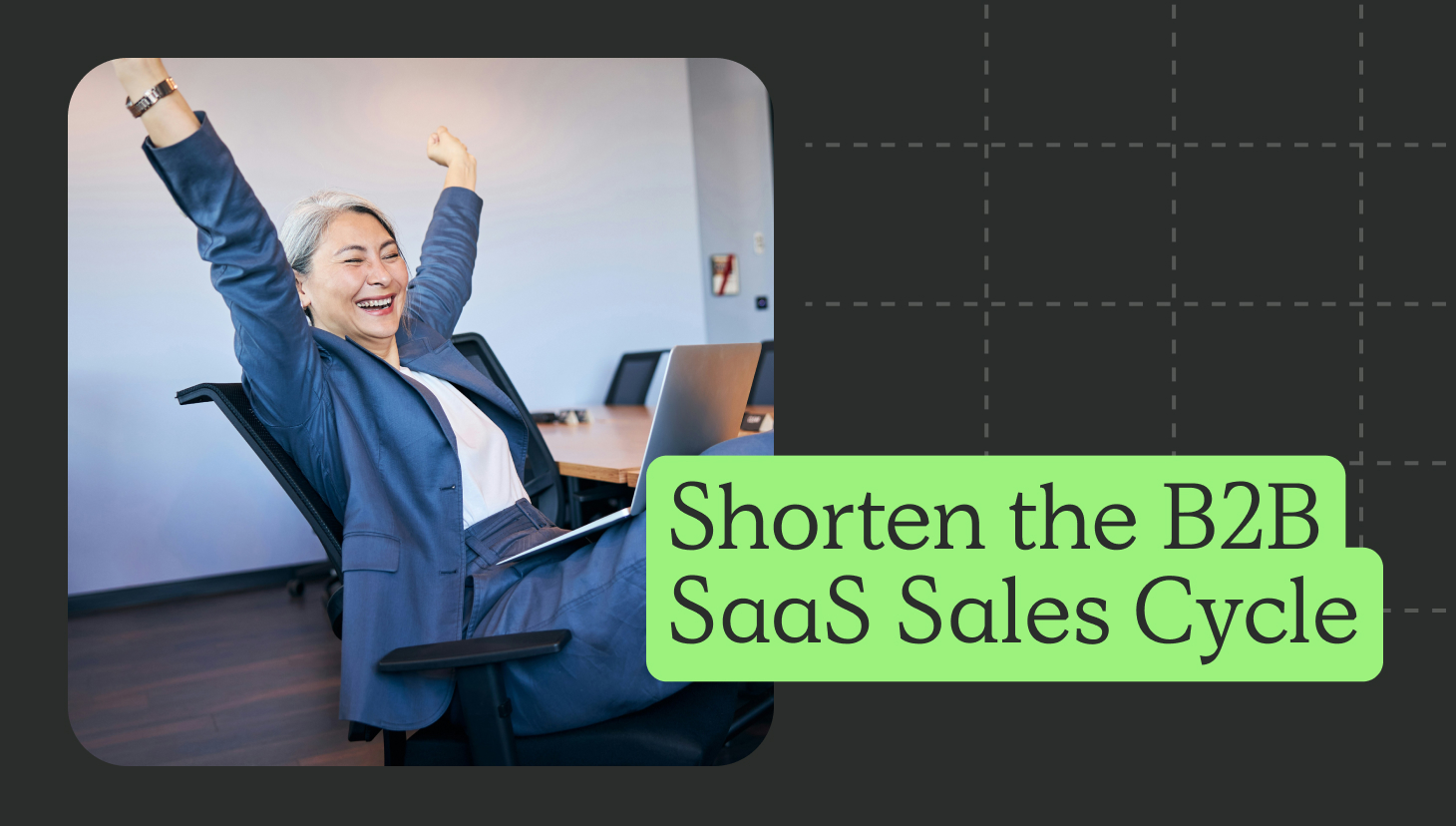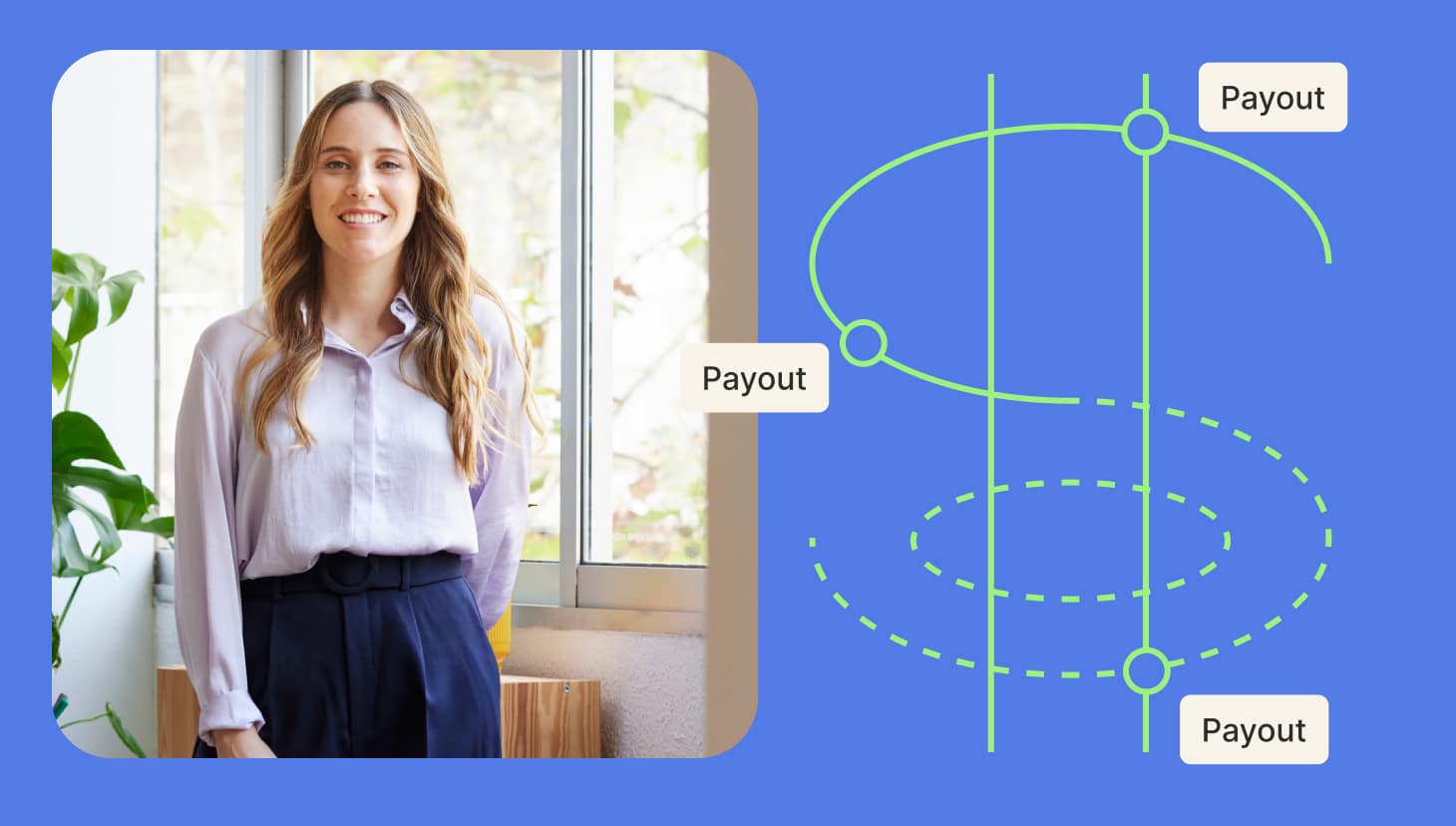The B2B SaaS market is certainly booming. It was estimated to be worth around $197 billion globally in 2023, and is predicted to reach $247 billion in 2024. It seems there is no shortage of companies looking for software solutions to help streamline their operations and improve productivity.
However, while you might have plenty of leads coming in, one of the biggest challenges often faced in the industry is the length of the sales cycle and how long it takes to turn those prospects into actual paying customers. A sales cycle that drags on isn’t just frustrating for your sales team, who want to close deals; it can also drain resources and impact your bottom line and the overall growth of your business.
So, how can you make your sales cycle more efficient and ultimately generate more revenue, faster? Let’s look at 10 strategies to speed things up.
1. Know Your Ideal Customer
The essential part of the sales process? Ensuring you’re speaking to somebody genuinely interested in purchasing your product. An Ideal Customer Profile (ICP) is like a blueprint of the kind of customer that your product or service would be most beneficial to.
Think about it: your product is best suited for them, and this makes them most likely to buy, which in turn means that you waste less time on dead leads and put your efforts into those prospects who are most likely to convert. Your ICP should include details like industry, company size, geographic location, and any other information you believe will make your product more relevant to them.
Defining Your ICP
Analyze your best customers
Look at your existing customer base and who your best customers are. What sort of things do they have in common? Looking for commonalities, like a certain industry or business size, can give you clues as to the sort of customer who gets the most value from your product.
Segment the market with data analytics
Use analytic tools for market segmentation. This means you can divide your target market into different groups based on their company profile.
For example, you might notice that medium-sized companies with between 200 and 500 employees most consistently convert in your pipeline, so these should be your key focus.
By segmenting your target market, you can exclude these types of prospects and focus your sales and marketing efforts on groups most likely to yield the best returns.
Regularly update your Ideal Customer Profile (ICP)
Market dynamics and customer needs change all the time, meaning defining your ICP is not a set-and-forget process.
Keep a close eye on what is happening in your pipeline and the wider market, and update your ICP as needed.
2. Use Data-Driven Insights
Using data-driven insights helps to do away with guesswork and make informed decisions at every step of the sales process. This reduces the need for trial and error and increases the chances of getting it right the first time. Use tools like CRM systems, marketing automation platforms, analytics software, or customer support software to track and review data, customer interactions, and sales activities.
You can then look for patterns and trends that will help you predict which sales leads are most likely to turn into sales and at which point in the sales cycle. A data integration process brings together disparate sources of information to break down silos and help you use data to best effect.
It’s important to stay abreast of CRM marketing trends, as these trends can provide insights into new tools and strategies that enhance customer engagement and lead conversion.
Additionally, you may use this data to create a 360 customer view. Knowing this, you can individualize communications in ways that mirror the uniqueness of your customers’ needs and preferences. This makes your sales team’s interactions more meaningful toward each customer, which can lead to more opportunities for successful sales.

Implementing Data-Driven Strategies
- Central CRM system: Adopt a CRM solution that truly centralizes customer information so your sales team does not waste time looking for information. This speeds up the process of communication and follow-ups.
- Predictive analytics: Use predictive analytics to forecast sales.
- Monitor SERP results: Keep an eye on your B2B SEO strategy, and adjust if your rankings start to drop.
- Continuously review and adjust strategies: Regularly review and tune strategies based on insights from the data.
3. Optimize Lead Qualification
This may sound counterintuitive, as it seems you are only going to lengthen the sales cycle with this extra step, but practicing lead qualification can actually shorten the sales cycle. The better the qualification process, the better the gatekeeper it serves for your sales pipeline.
One way to do this is by using a scoring methodology before passing the leads to the sales team. This method allows the sales team to distinguish between a prospect or lead, so they can concentrate on only those prospects who identify under your buyer persona and have an actual interest in what you are selling.
How to Optimize Lead Qualification
- Develop a lead-scoring framework: Look for any common factors amongst your customers that most often convert. This could be things like the size of their organization, the industry they’re in, the prospect’s job title, or the location of the business. For example, you might spot that initial enquiries made by decision-makers within medium-sized businesses convert more often and faster than those from more junior roles in large organizations. In addition to this, analyze any behavioral data you have on your prospects. Website visits, content downloads, email opens, and webinar attendance can all indicate more interest in your products and a more promising lead.
- Score each of the demographic and behavioral factors: Now, give each of these demographic and behavioral factors a score. You want to give the highest scores to industry targets or high-value actions, like requesting a product demo or scheduling a discovery call. B2B database providers can provide a solution to store this information for you.
- Establish a scoring threshold: Once you have a scoring system in place, establish a threshold that a lead must meet or exceed for you to consider them qualified. This system means that only quality leads that have a high chance of converting are put into the hands of the sales team.
4. Increase Your Value Proposition
A strong value proposition clearly highlights your product’s unique benefits for customers to see. Getting this right can shorten your sales cycle from day one.
How? It can help in two ways. Firstly, it allows you to filter out any leads where your product doesn’t address their business need. By giving prospects the information on your product from the start, they will have a better idea if it’s a good fit for them without wasting your sales team’s time following up on dead-end inquiries.
Secondly, a strong value proposition should do half the sales job for you. It will address the pain points of your target audiences and demonstrate how you will solve them, effectively already warming up leads to what you have to offer and getting them excited about your product.
Tips for Developing a Value Proposition

- Outline the key benefits and ROI: Include examples and data that show prospects in a tangible way how your product could save them time, reduce costs, or increase productivity.
- Provide social proof via case studies and testimonials: Include case studies and quotes from satisfied customers to build credibility and trust in new contacts (we’ll cover this in more detail later).
- Personalize your message for each audience segment: Show that you understand their individual pain points and priorities by replacing generic sales messages with personalized ones that take into account things like your prospect’s industry, business size, or job role.
5. Streamline Your Sales Process
To shorten the sales cycle, your sales team needs to be able to move prospects through the pipeline as quickly and efficiently as possible. This doesn’t mean getting sloppy or cutting corners, but making sure that each step of the process is working as smoothly as it can.
Start by mapping out each stage of the sales process and identifying any points of friction or inefficiency that are causing your sales process to go from speeding along to grinding to a halt. This map details how prospects move along the sales journey from one step to another and typically includes activities like lead generation, initial contact, needs assessment, proposal, negotiation, and closing.
Accompanying each step should be specific actions, who is responsible for them, and the ideal outcome. For example, when it comes to the needs assessment, your action could be having a rep host a discovery call to learn more about the prospect’s challenges and goals.
Look into historical data to see where, in this process, prospects most often drop off or deals get stuck in your pipeline. Then, speak to the sales team to understand what isn’t working and where the bottlenecks are.
You can keep on top of the ongoing performance of your sales process by keeping watch on metrics like conversion rates, average deal cycle length, and win rates. Depending on the methods you prefer, it can be worth investing in Kanban software or task management tools to monitor the process.
Streamlining Strategies
Here are some ideas for ways you can speed up the sales process:
- Standardize your sales process and activities: Free up your sales team’s time by standardizing repetitive tasks early in the pipeline. You could provide them with marketing email templates, pre-drafted proposals, or sales scripts. This gives them more time to focus on what they do best – closing deals.
- Use tools and automation: Let technology do the hard work for you and take advantage of tools like VoIP for small business. These tools can integrate with your productivity apps to streamline your processes, saving your sales team precious time.
- Refine your sales process: The trick to keeping your sales processes slick is never getting complacent. Ongoing training and development will ensure your sales team are always at the top of their game, equipped with the practical skills and knowledge to close more deals faster. Provide periodic training on new selling approaches, product updates, and current industry trends.

6. Provide Full-Featured Product Demonstrations
Presentations and demonstrations should be at the heart of your SaaS sales cycle. A good demonstration can do miracles to lead a sale further down the closing process. It can give you the opportunity to show your prospect how your product can really address their business need, and respond to any concerns or queries they might have.
Product demonstrations aren’t a one-size-fits-all process. Be sure that the demo you are giving is tailored to your individual prospect to show them the features that will be appealing to them. For instance, if they’ve highlighted issues with their system going down and they’re unsure why, spend some extra time on your uptime monitoring and cybersecurity features.
You might focus on showcasing a specific feature or functionality that solves a problem, or demonstrating the user-friendliness of your product to a prospect who is apprehensive about team onboarding. Ultimately, the role of your demo should be for your prospect to walk away thinking, “This is exactly what we need.”
Effective Demo Strategies
- Address the prospect’s pain points: Customize product demonstrations to address a prospect’s pains and challenges specifically. This way, a buyer is going to find your product more relevant because they can understand how it is going to fix their own unique needs.
- Use interactive and engaging presentation methods: Don’t stick to the confines of a traditional PowerPoint deck. Make use of interactivity and interesting presentation techniques. This includes live product demonstrations, hands-on exercises, and dynamic visual aids that make the presentation more memorable.
- Send follow-up materials and answers to questions: Immediately after the demonstration, forward follow-up material that reinforces the main points that were discussed and provides answers to any questions raised during the presentation. This shows attentiveness and gives the prospect all the information they need to make an informed decision. An AI meeting recorder can help you make sure you don’t miss any important details.
7. Work with a Customer-Centric Approach
Being customer-centric means putting the agenda, or concerns, of your prospects first through the whole selling process. It sounds simple, but being truly customer-centric takes a considered effort at every twist and turn of the sales process.
In return, though, you’ll build confidence and better relations amongst your prospects, and that means there is more chance they will buy your product.
Customer-Centric Tactics
- Take the time to genuinely listen to and answer any potential apprehensions from your prospects. Don’t just fob them off with standard responses about how great your product is, but understand and address their concerns practically and empathetically.
- Provide them with personal advice or solutions, demonstrating that you understand their business and needs.
- Keep in touch through consistent and transparent communication. Consider using tools like an omnichannel contact center platform so leads can communicate with your sales team in a variety of ways. It could be email, business phone systems, live chat, social media, or messaging apps. Allowing them to reach out to you in the way they prefer speeds up initial contact and follow-up interactions.
- Enhance responsiveness with automated text messages. By integrating automated texting into your communication strategy, you ensure timely, personalized updates and reminders are sent to prospects, keeping them engaged and informed throughout the sales process.
8. Use Social Proof and Case Studies
When looking for confidence in buying a product, we often turn to the reviews section to check out other customers’ experiences, and the B2B market is no different.
You can harness the power of your satisfied customers by using case studies, testimonials, or reviews as social proof that can work effectively in closing a sale.
Showing successful applications for your product in real-world examples can help reassure prospects that your product is indeed valuable and practical, rather than just taking your word for it.
How to Leverage Social Proof
- Share Case Studies: Show how other customers are using your product to achieve measurable results.
- Display Customer Testimonials: Feature testimonials from happy customers on your website. Investigate AI SEO tools to see what gives the best results.
- Incorporate Reviews and Ratings: Include reviews and ratings in your sales materials.

9. Offer Flexible Pricing and Payment Options
Do your leads flow promisingly through your sales pipeline until they hit the dreaded roadblock of agreeing on pricing and payment?
You can make your product accessible to a wider range of people by facilitating flexible pricing and payment options. Think about introducing features like tiered price plans, long-term commitment discounts, or flexible payment terms.
Use an automated recurring billing system to give your customers the freedom to choose how they pay and pause or cancel subscription billings at any time if they wish.
Pricing Strategies
- Develop pricing tiers: Having one set price that includes all the bells and whistles could make your product unaffordable for some prospects. Instead, consider introducing pricing tiers to make your product more accessible to different segments of customers. For instance, a simple three-tier approach might include basic, standard, and premium plans, with different features included under each plan.
- Enable easy market access: Offer free trials or freemium models. This lowers any barriers to entry and gives prospects a chance to experience the value of your product first-hand without having to make any financial commitment. Once they’ve seen how great your product is, you can convert trial users into paying customers.
Clearly show pricing information, or indicative pricing, on your website and marketing materials. This pricing transparency helps prospects quickly determine whether your product fits their budget, and saves difficult pricing objections later on in the sales process.
10. Handle Objection Proactively
Even the best sales team will encounter objections in the sales cycle, but it’s how they handle them that counts. When you can handle objections confidently and effectively, you can stop them from stalling the sales process.
Be prepared for possible objections and have answers ready that will directly address the concerns of the prospect.
Objection Strategies
- Know common objections in advance: The first step is understanding common objections raised by prospects. Some typical common objections might include problems with price, product fit, challenges during implementation, issues over ROI, and lack of confidence in the company’s reputation. Identifying these usual objections beforehand puts the sales teams in a better position to brace themselves proactively.
- Build a repository of responses and solutions: Now that you know the most common objections, the next step is to develop well-crafted responses and solutions that can address these concerns. Having a repository of responses ensures your team members can quickly and confidently counter the objection during a sales call.
- Train your sales team to handle objections confidently: Training your sales team is essential for them to take care of objections confidently and with ease. The training process should include the theoretical aspects of objection handling and practical, hands-on experience.

Reducing Sales Cycle Duration: Key Takeaways
A short sales cycle accelerates revenue, makes it easier to adapt to changes in market and customer requirements quickly, and promotes better use of resources. It improves customer satisfaction and results in quick investment returns by closing deals more swiftly.
If you’re looking to improve your bottom line, taking steps to shorten the length of your sales cycle could be one of the most important initiatives to consider. Even if your sales cycle looks to be performing well, getting more deals over the line, and quicker, means you’re driving more revenue. And that’s never a bad thing.



